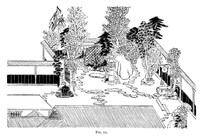The smaller stones are of sufficient size for the foot to rest firmly upon, and should not, as a general rule, be higher than two inches from the soil. In ancient times, it is said that "Stepping Stones" for the Emperor's gardens were made six inches high, those for a Daimio four inches, those for ordinary Samurai nearly three inches, and for common folk an inch and a half in height. The larger stones are intended as a rest for both feet, and two of them should never be used consecutively. Fig. 11 illustrates a small garden, belonging to a merchant at Sakai, in which may be seen several continuous pathways formed of "Stepping Stones." When such walks branch off in two directions a larger and higher stone, called the "Step-dividing Stone" (Fumiwake-ishi), will be placed at the point of divergence. This stone is occasionally known by the fancy name of "Snail Stone" (Garan-seki), from some supposed resemblance to a gigantic snail or slug. A similar word�Garan�written with a different ideograph, means a "Statue Pedestal;" and some writers, in explanation of its application to the "Step-dividing Stone," state that once upon a time a certain priest used the pedestal of a Buddhist statue for the purpose. The above arrangements of "Stepping Stones" are shown in Plate III.

